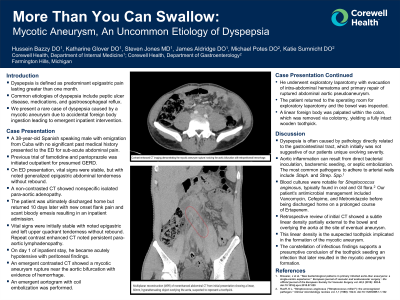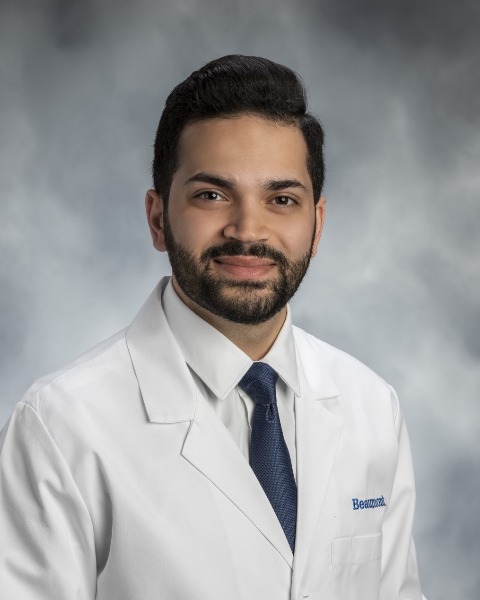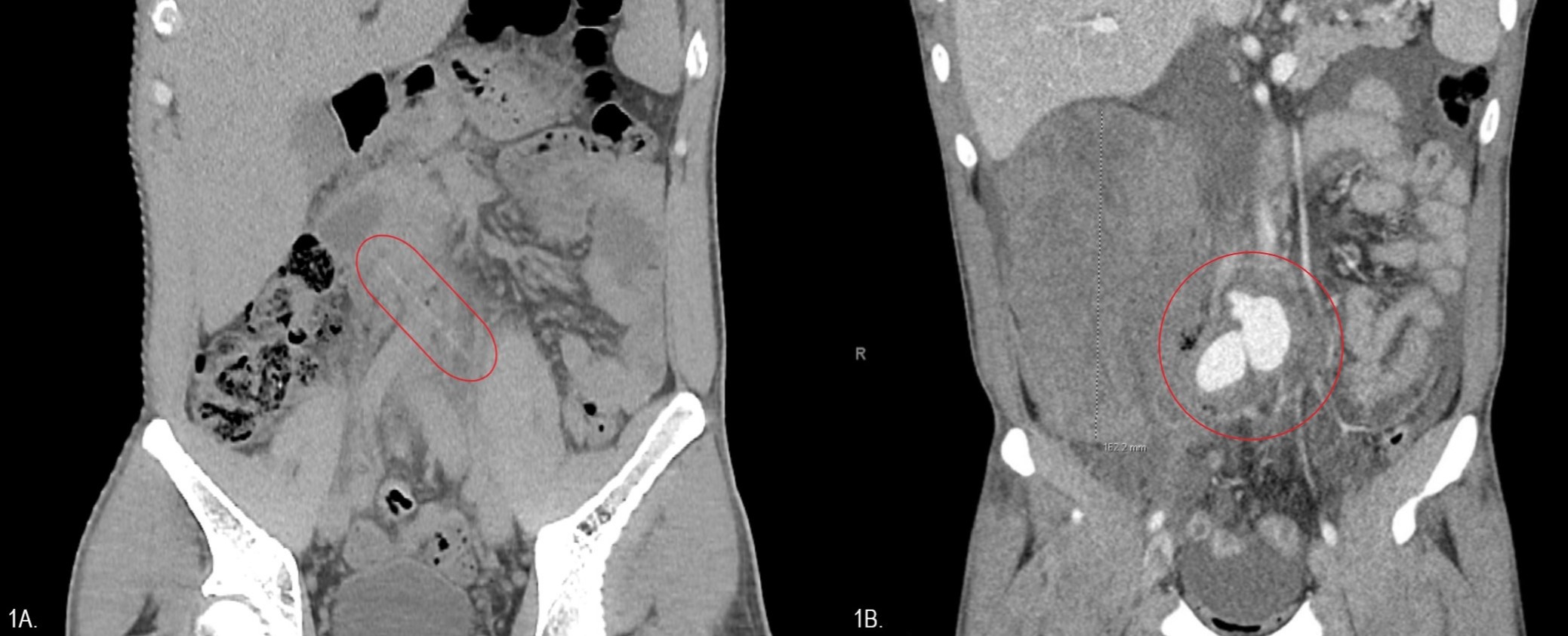Sunday Poster Session
Category: Small Intestine
P1336 - More Than You Can Swallow: Mycotic Aneurysm, an Uncommon Etiology of Dyspepsia
Sunday, October 22, 2023
3:30 PM - 7:00 PM PT
Location: Exhibit Hall

Has Audio

Hussein Bazzy, DO
Corewell Health
Farmington Hills, MI
Presenting Author(s)
Award: Presidential Poster Award
Katharine Glover, DO, Steven Jones, MD, James Aldridge, DO, Michael Potes, DO, Katie Sumnicht, DO, Hussein Bazzy, DO
Corewell Health, Farmington Hills, MI
Introduction: Dyspepsia is defined as predominant epigastric pain lasting greater than one month. Common etiologies of dyspepsia include peptic ulcer disease, medications, and gastroesophageal reflux. We present a rare case of dyspepsia caused by a mycotic aneurysm due to accidental foreign body ingestion leading to emergent inpatient intervention.
Case Description/Methods: A 38-year-old Spanish speaking male with no past medical history presented to the ED for subacute abdominal pain. Previous trial of famotidine and pantoprazole was initiated outpatient for presumed GERD. On ED presentation, vital signs were stable, but with noted generalized abdominal tenderness without rebound. A non-contrasted CT showed nonspecific isolated para-aortic adenopathy. The patient was ultimately discharged home but returned 10 days later with new onset flank pain and scant bloody emesis. Vital signs were again stable with noted epigastric and left upper quadrant tenderness without rebound. Repeat contrast enhanced CT noted persistent para-aortic lymphadenopathy. He was admitted, blood cultures were drawn, and broad-spectrum antibiotics were initiated. On day 1 of inpatient stay, he became acutely hypotensive with peritoneal findings. An emergent contrasted CT showed a mycotic aneurysm rupture near the aortic bifurcation with evidence of hemorrhage. An emergent aortogram with coil embolization was performed. He underwent exploratory laparotomy with evacuation of intraabdominal hematoma and primary repair of ruptured abdominal aortic pseudoaneurysm. The following day, the patient returned to the OR, which yielded a linear foreign body within the colon. The foreign body was removed via colotomy, later described to be a toothpick by pathology.
Discussion: Dyspepsia is often caused by pathology directly related to the gastrointestinal tract, which initially was not suggestive of our patients unique evolving severity. Blood cultures were notable for Streptococcus Anginosus, typically found in oral and GI flora. Retrospective review of initial CT showed a subtle linear density partially external to the bowel and overlying the aorta at the site of eventual aneurysm. This linear density is the suspected toothpick implicated in the formation of the mycotic aneurysm. It remains unclear why the toothpick was later found in the colon. The constellation of infectious findings supports a presumptive conclusion of the toothpick seeding an infection that later resulted in the mycotic aneurysm formation.

Disclosures:
Katharine Glover, DO, Steven Jones, MD, James Aldridge, DO, Michael Potes, DO, Katie Sumnicht, DO, Hussein Bazzy, DO. P1336 - More Than You Can Swallow: Mycotic Aneurysm, an Uncommon Etiology of Dyspepsia, ACG 2023 Annual Scientific Meeting Abstracts. Vancouver, BC, Canada: American College of Gastroenterology.
Katharine Glover, DO, Steven Jones, MD, James Aldridge, DO, Michael Potes, DO, Katie Sumnicht, DO, Hussein Bazzy, DO
Corewell Health, Farmington Hills, MI
Introduction: Dyspepsia is defined as predominant epigastric pain lasting greater than one month. Common etiologies of dyspepsia include peptic ulcer disease, medications, and gastroesophageal reflux. We present a rare case of dyspepsia caused by a mycotic aneurysm due to accidental foreign body ingestion leading to emergent inpatient intervention.
Case Description/Methods: A 38-year-old Spanish speaking male with no past medical history presented to the ED for subacute abdominal pain. Previous trial of famotidine and pantoprazole was initiated outpatient for presumed GERD. On ED presentation, vital signs were stable, but with noted generalized abdominal tenderness without rebound. A non-contrasted CT showed nonspecific isolated para-aortic adenopathy. The patient was ultimately discharged home but returned 10 days later with new onset flank pain and scant bloody emesis. Vital signs were again stable with noted epigastric and left upper quadrant tenderness without rebound. Repeat contrast enhanced CT noted persistent para-aortic lymphadenopathy. He was admitted, blood cultures were drawn, and broad-spectrum antibiotics were initiated. On day 1 of inpatient stay, he became acutely hypotensive with peritoneal findings. An emergent contrasted CT showed a mycotic aneurysm rupture near the aortic bifurcation with evidence of hemorrhage. An emergent aortogram with coil embolization was performed. He underwent exploratory laparotomy with evacuation of intraabdominal hematoma and primary repair of ruptured abdominal aortic pseudoaneurysm. The following day, the patient returned to the OR, which yielded a linear foreign body within the colon. The foreign body was removed via colotomy, later described to be a toothpick by pathology.
Discussion: Dyspepsia is often caused by pathology directly related to the gastrointestinal tract, which initially was not suggestive of our patients unique evolving severity. Blood cultures were notable for Streptococcus Anginosus, typically found in oral and GI flora. Retrospective review of initial CT showed a subtle linear density partially external to the bowel and overlying the aorta at the site of eventual aneurysm. This linear density is the suspected toothpick implicated in the formation of the mycotic aneurysm. It remains unclear why the toothpick was later found in the colon. The constellation of infectious findings supports a presumptive conclusion of the toothpick seeding an infection that later resulted in the mycotic aneurysm formation.

Figure: 1A. Multiplanar reconstruction (MPR) of nonenhanced CT of the abdomen and pelvis from initial presentation showing a linear, 60mm, hyperattenuating object overlying the aorta, suspected to represent a toothpick.
1B. Coronal, contrast enhanced CT of the abdomen and pelvis showing a 16.2cm heterogeneous fluid collection consistent with retroperitoneal hematoma from ruptured mycotic aneurysm.
1B. Coronal, contrast enhanced CT of the abdomen and pelvis showing a 16.2cm heterogeneous fluid collection consistent with retroperitoneal hematoma from ruptured mycotic aneurysm.
Disclosures:
Katharine Glover indicated no relevant financial relationships.
Steven Jones indicated no relevant financial relationships.
James Aldridge indicated no relevant financial relationships.
Michael Potes indicated no relevant financial relationships.
Katie Sumnicht indicated no relevant financial relationships.
Hussein Bazzy indicated no relevant financial relationships.
Katharine Glover, DO, Steven Jones, MD, James Aldridge, DO, Michael Potes, DO, Katie Sumnicht, DO, Hussein Bazzy, DO. P1336 - More Than You Can Swallow: Mycotic Aneurysm, an Uncommon Etiology of Dyspepsia, ACG 2023 Annual Scientific Meeting Abstracts. Vancouver, BC, Canada: American College of Gastroenterology.

